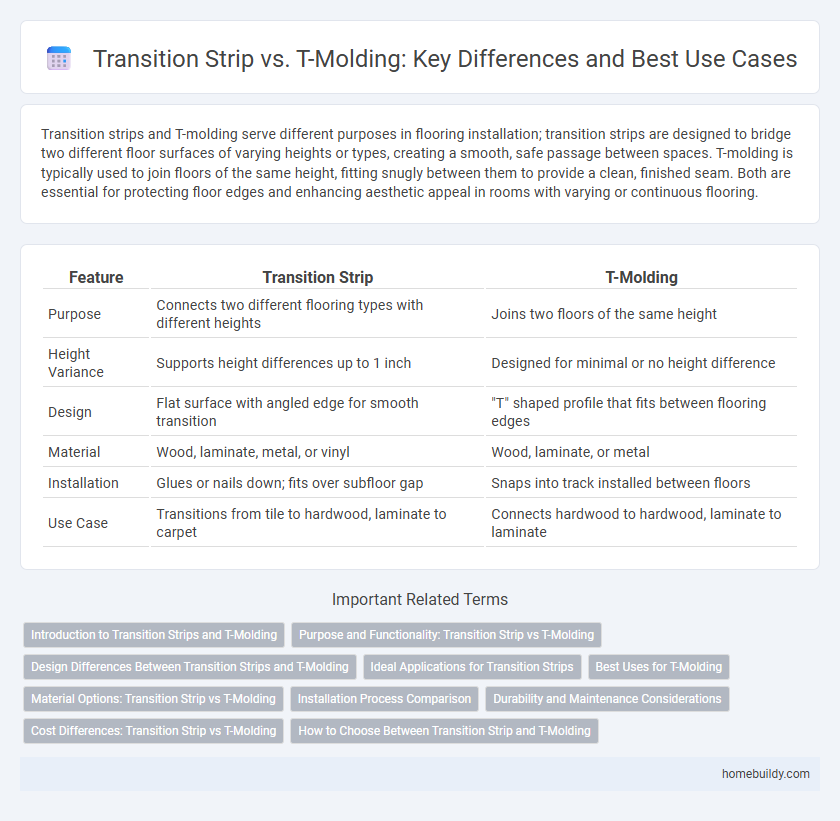Transition strips and T-molding serve different purposes in flooring installation; transition strips are designed to bridge two different floor surfaces of varying heights or types, creating a smooth, safe passage between spaces. T-molding is typically used to join floors of the same height, fitting snugly between them to provide a clean, finished seam. Both are essential for protecting floor edges and enhancing aesthetic appeal in rooms with varying or continuous flooring.
Table of Comparison
| Feature | Transition Strip | T-Molding |
|---|---|---|
| Purpose | Connects two different flooring types with different heights | Joins two floors of the same height |
| Height Variance | Supports height differences up to 1 inch | Designed for minimal or no height difference |
| Design | Flat surface with angled edge for smooth transition | "T" shaped profile that fits between flooring edges |
| Material | Wood, laminate, metal, or vinyl | Wood, laminate, or metal |
| Installation | Glues or nails down; fits over subfloor gap | Snaps into track installed between floors |
| Use Case | Transitions from tile to hardwood, laminate to carpet | Connects hardwood to hardwood, laminate to laminate |
Introduction to Transition Strips and T-Molding
Transition strips are flooring accessories designed to bridge the gap between different types or heights of flooring materials, ensuring a smooth and safe transition. T-molding, a specific type of transition strip, is shaped like a "T" and fits into a gap between two floors of similar height, providing an even and visually pleasing connection. Both elements are essential for maintaining floor integrity and enhancing aesthetic flow in multi-surface spaces.
Purpose and Functionality: Transition Strip vs T-Molding
Transition strips bridge flooring materials of different heights or types, providing a smooth and safe surface to prevent tripping hazards. T-molding serves primarily to connect floors of the same height, creating a seamless transition between rooms or sections. Both enhance floor appearance and durability, but their functionality targets specific flooring scenarios based on height differences and material compatibility.
Design Differences Between Transition Strips and T-Molding
Transition strips feature a beveled edge designed to bridge flooring of different heights or materials, creating a smooth and safe transition. In contrast, T-molding has a symmetrical T-shaped profile that fits into expansion gaps between floors of the same height, providing a seamless and flexible connection. While transition strips often accommodate changes in floor thickness, T-molding is ideal for maintaining a uniform surface between adjacent areas.
Ideal Applications for Transition Strips
Transition strips are ideal for connecting flooring materials of different heights or types, such as hardwood to tile or laminate to carpet, providing a smooth and safe transition. They effectively fill gaps and accommodate slight height differences, preventing tripping hazards and floor damage. Common applications include doorways, room transitions, and areas where expansion gaps need to be covered.
Best Uses for T-Molding
T-molding is best used for connecting two floors of equal height, creating a clean and seamless transition that accommodates slight expansion and contraction of flooring materials. Its design is ideal for doorways, hallways, and between rooms with hardwood, laminate, or vinyl flooring where a flush, professional finish is desired. Compared to transition strips, T-molding provides better flexibility and aesthetic appeal for continuous flooring surfaces without height differences.
Material Options: Transition Strip vs T-Molding
Transition strips typically come in materials like wood, vinyl, aluminum, and rubber, offering flexible options for various flooring types and transitions. T-molding is most commonly available in hardwood, MDF with veneer, or laminate, designed to bridge floors of the same height, particularly in hardwood or laminate installations. The choice between transition strips and T-molding material depends largely on the specific flooring surfaces and height differences needing to be covered.
Installation Process Comparison
Transition strips install by securing directly to the subfloor with nails or adhesive, creating a smooth connection between different flooring types or heights. T-molding requires precise measurement and is typically inserted into a track or glued down to bridge gaps between floors of the same height. The transition strip installation tends to be simpler and faster, while T-molding demands more accuracy to ensure a seamless finish.
Durability and Maintenance Considerations
Transition strips offer superior durability compared to T-molding, especially in high-traffic areas due to their thicker profile and robust materials like aluminum or hardwood. Maintenance of transition strips is generally easier, requiring less frequent replacement and simple cleaning techniques, while T-molding may wear out faster and demand more frequent attention to prevent damage. Choosing transition strips can lead to longer-lasting floor transitions with reduced upkeep costs over time.
Cost Differences: Transition Strip vs T-Molding
Transition strips generally cost less than T-molding due to simpler materials and installation processes, making them a budget-friendly choice for flooring transitions. T-molding, designed for connecting similar floor heights, often involves higher-quality materials and precision fitting, resulting in increased expenses. Choosing between the two depends on budget constraints and flooring requirements, with transition strips offering affordable versatility compared to the specialized nature of T-molding.
How to Choose Between Transition Strip and T-Molding
Choosing between a transition strip and T-molding depends on the flooring types and height differences involved; transition strips are ideal for connecting different flooring materials with varying heights, such as hardwood to tile. T-molding works best for floors of similar height, like two hardwood or laminate surfaces, providing a smooth, flush connection. Consider factors like floor height variance, expansion gaps, and aesthetic preferences to select the most functional and visually appealing option.
Transition strip vs T-molding Infographic

 homebuildy.com
homebuildy.com